









April 22, 2006 - Post No. 61

At 9 a.m. we gather again at the entrance of the monastery for the second procession of many over the weekend down to the great Jerusalem Church of the Resurrection. Fr. Goossan, Dragoman of the Armenian Monastery (sort of the prime minister) carries the key to open the door of the Church of the Resurrection on its busiest day of the year, when the famous ceremony of the Holy Fire is scheduled to take place.
He walks beside Mr. Judeh (wearing a hat) the current keeper of the key. To avoid squabbles and jealousies between the different Christian groups (not that this really works!) the Judehs, a Moslem family in the old city, have been entrusted with the care of the key for "only the past 800 years," Mr. Judeh tells me at breakfast.
The Armenian Orthodox have the privilege of opening the door of the
Church of the Resurrection (the Holy Sepulchre) on Saturday in Holy
Week, both the western and the orthodox.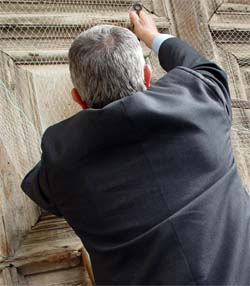 Three groups have a role in the direction of the great basilica, the
Franciscans, the Greek Orthodox and the Armenians; and each represents a
larger group respectively, the Roman Catholics, the Byzantine Orthodox,
and the Oriental Orthodox. The Franciscans open the door on Thursday of
Holy Week, the Greeks on Friday, and the Armenians, today, Great
Saturday.
Three groups have a role in the direction of the great basilica, the
Franciscans, the Greek Orthodox and the Armenians; and each represents a
larger group respectively, the Roman Catholics, the Byzantine Orthodox,
and the Oriental Orthodox. The Franciscans open the door on Thursday of
Holy Week, the Greeks on Friday, and the Armenians, today, Great
Saturday.
The opening of the door for Great Saturday is quite a media event, and Fr. Goossan and Mr. Judeh are swarmed by paparazzi as Mr. Judeh's Moslem colleague, Mr. Wagehe Nasebe climbs a ladder to unlock the door.
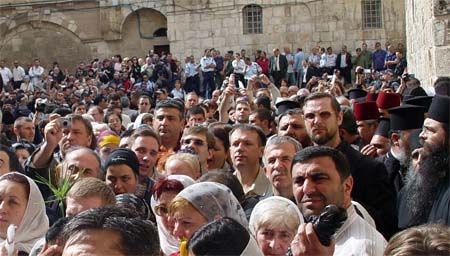
Once open the tide of pilgrims begins to roll into the Church of the Resurrection. Haaretz, the Israeli English daily, reports later that 15,000 will have squeezed into the basilica by 2 p.m. when the ceremony of the Holy Fire is scheduled to take place.
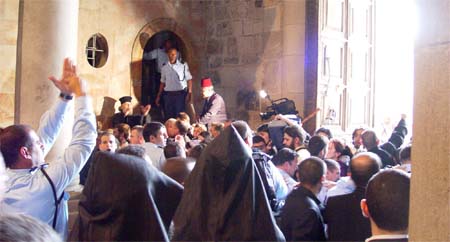
There is something that might look like the Biblical sorting of the goats from the sheep going on throughout the day at the great doorway of the basilica. The Byzantine Orthodox are sent off to the right and the Oriental Orthodox to the left. separation barriers are set up throughout the great basilica and each national tradition (Greek, Russian, Rumanian, Armenian, Syrian, Coptic, and Ethiopian ... ) has its reserved space.
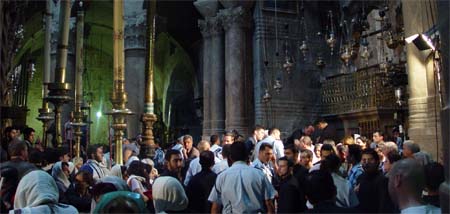
Haaretz reports that there were 3,000 Israeli police on hand to control the crowd, just about enough. Most of the problem has simply to do with the crush of humanity around the Aedicule where things can get a bit "heated" from time to time, particularly when (pictured, below) an insistent intruder wants to stand in the area reserved for the Armenian pilgrims.
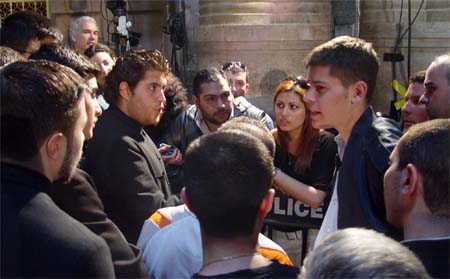
The real problem is that there isn't enough room for everybody, 400 or the 700 Armenian pilgrims will be left standing in the courtyard outside and spilling into the streets beyond, and pilgrims travel great distances to stand in the spaces reserved for them. Tempers can rise a bit when an interloper takes space reserved for someone else ... and so it goes.
Archbishop Nourhan will later accuse the Israeli police of arbitrarily blocking access to the Church of the Resurrection saying (as reported in Haaretz), "Israel always declares that it allows fee access to the holy places but in fact the police acted like a despot to the pilgrims. There were some who had come especially for the ceremony from the U.S., from Canada and from Australia who were not allowed in (even though they had official entry permits.)"
Haaretz reports Archbishop Nourhan met on the eve of the ceremony with the commander of the Jerusalem district of the police, Major General Ilan Franko, and asked him to treat the pilgrims politely. However he said Frank "spoke to me as if I were a student of his, and hinted all the time that if we did not abide by the agreements ... (sic)"
Fr. Samuel represents the Armenian Patriarch serving as one of the
three members of basilica's executive committee (also a Franciscan and a
Greek monk.) He is in charge of the area in front and beside the
Aedicule, and I can't help but admire Fr. Samuel's calm as he directs
traffic and tries to sort out the endless round of conflicts over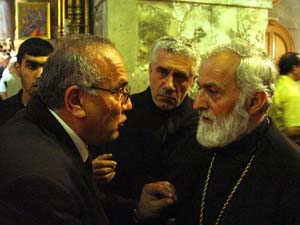 allotted space in the building. In this photo, two representatives from
the Syrian Orthodox contingent come to complain that they have no
electricity in their area. Each of the traditions seem to have some
space for storage in addition to their own chapels and designated
worship areas. For some reason there is no electrical power in the
Syrian space, and Fr. Samuel is the man to talk to in a situation like
this. Frustration is evident in the voices of the Syrians -- how
could Fr. Samuel allow such an injustice to take place! -- but Fr.
Samuel keeps his cool, listening attentively he suggests that the
Syrians might check the power breakers in the fuse box in the balcony of
their the area, this seems to do the trick.
allotted space in the building. In this photo, two representatives from
the Syrian Orthodox contingent come to complain that they have no
electricity in their area. Each of the traditions seem to have some
space for storage in addition to their own chapels and designated
worship areas. For some reason there is no electrical power in the
Syrian space, and Fr. Samuel is the man to talk to in a situation like
this. Frustration is evident in the voices of the Syrians -- how
could Fr. Samuel allow such an injustice to take place! -- but Fr.
Samuel keeps his cool, listening attentively he suggests that the
Syrians might check the power breakers in the fuse box in the balcony of
their the area, this seems to do the trick.

Things get a bit rowdy when the Syrian youth arrive about an hour
before the schedule ceremony of the Holy Fire. Some of them look like
the members of the national rugby side, a couple are carried around on
the shoulders of their buddies amid tribal drumbeats, vibrato hoots, and
cheers from the Syrian contingent affirming something along the order of
"We're number one!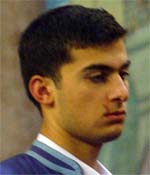 "
"
At one point there is a bump or a push between an Armenian and a Syrian youth and pandemonium ensues with a few bloodied shirts and swollen lips visible later to tell the tale -- note the upper lip of the Armenian seminarian pictured here. As soon as the "dust has settled" the number of black robed Armenian seminarians mysteriously doubles, and many of the new recruits have rather broad shoulders and powerful builds.
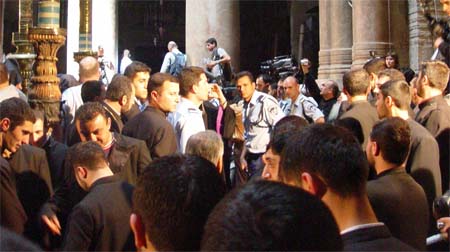
To many an onlooker this must all seem like the consummate hypocrisy, such rabble rousing and preventive measures at the tomb of the Prince of Peace! But to this dispassionate observer even the brief outbreak of fighting seems somehow to make sense in the energy charged atmosphere of the Empty Tomb. We are all gathered today, squeezed together taking up every available inch of space, to mark a remarkable event in the history of humanity, one of intense power and beauty that continues to touch us today after nearly 2000 years -- all rather overwhelming really for the small human creature, it's a small wonder that the best and the worst of the human species are evident here today -- this is much more than a simple ceremony.
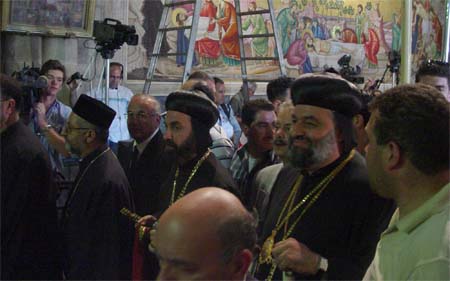
Not long after the melee, the Syrian Archbishop of Jerusalem and the visiting Syrian archbishop from New Jersey arrive with their entourage of decidedly more sedate and better behaved faithful. The Armenian Patriarch of Istanbul, representing the Patriarch of Jerusalem, arrived earlier and word has it that the Greek Patriarch is already here as well. Soon the great liturgy of the Holy Fire will begin. It is easily the shortest and possibly the biggest liturgy in the orthodox world, lasting only a few minutes but taking hours to prepare.
 Part
of the preparations include providing a bit of a kick to the bundle of
candles that will be used in the ceremony. Waiting in the Armenian
sitting room near the Aedicule, with the Patriarch of Istanbul sitting
near-by, this gentleman carefully pours a cap full of naphtha, or some
other form of liquid combustible -- into the top of each of each of the
four large bundles of candles to be used in the service.
Part
of the preparations include providing a bit of a kick to the bundle of
candles that will be used in the ceremony. Waiting in the Armenian
sitting room near the Aedicule, with the Patriarch of Istanbul sitting
near-by, this gentleman carefully pours a cap full of naphtha, or some
other form of liquid combustible -- into the top of each of each of the
four large bundles of candles to be used in the service.
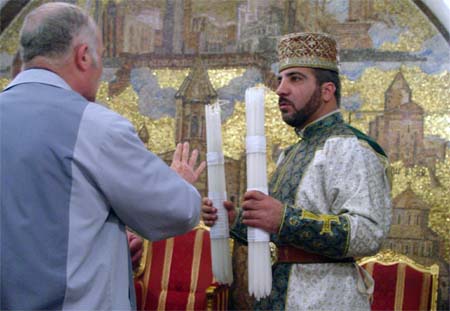
For the second year in a row, Fr. Pakrod has the honour of serving as the luce han -- the one who "brings out the light" from the inner sanctum of the Aedicule, where Jesus is believed to have been buried.
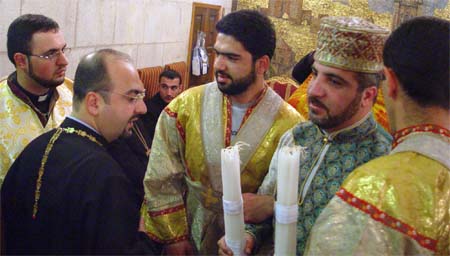
In theory, he and the Greek light bringer outer (?) are searched for any instruments that could kindle a fire (matches, lighter, etc.) so there can be no doubt that the fire that appears in the tomb at a set hour, does so each year miraculously, an act of God. The naphtha just serves to ensure that however the fire is kindled it will burn brightly when the luce han carries it out of the Aedicule.

Soon, around 2:15 p.m., the moment comes for the Greek light bearer to enter the Aedicule first, followed by the Armenian. The tradition, up to a couple of years ago, was for the two monks, the Armenian and the Greek, to be together in the inner chamber over the mortuary slab, to receive the Holy Fire. During the reign of the former, and now deposed, Greek Patriarch Irineos I, things changed; and even this year, despite agreements to renew the old tradition, the Greek light bearer enters the tomb first, receives the fire, and leaves before the Armenian luce han can join him.
All eyes are on the Aedicule, where a small oval window gives a few privileged pilgrims first site of the fire when it is passed through the oval window to an Armenian runner -- a sturdy man who comes over each year from Jordon for this duty -- who then carries the flaming bundle of candles up the stairway to the Armenian patriarch waiting in the gallery chapel to bless the Armenian pilgrims below with the new fire of Easter.
As the flame comes through the window of the Aedicule a great cheer rises at the first site of the Holy Fire, and all the bells of the basilica, notably its great bells, begin to sound in great excitement.

Before long the basilica is ablaze with fire. Pilgrims hold bundles of thirty-three candle sticks one for each year of the Saviour's human life, and the flame is passed from hand to hand until the great basilica is ablaze with fire light.
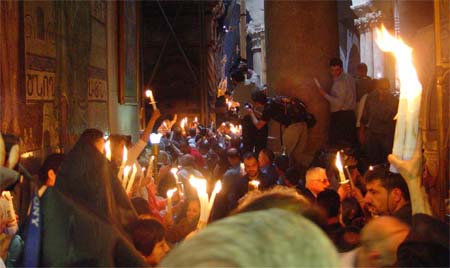
The luce han is carried on the shoulders of a couple of sturdy deacons, his job is to bring the light safely to the Armenian sitting room nearby. I stand in the door way of the sitting room to take the two pictures, above. Click here for a rather remarkable film, if I do say so myself, taken as the luce han arrives in the Armenian sitting room.
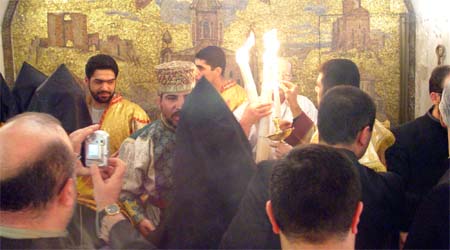
Once the light has been delivered, the monks come to embrace the luce han, to congratulate him for his effort, and to hear the "blow by blow" account of the antics that took place inside the Aedicule (the Greek monk jumping queue.)

Meanwhile a procession forms, everyone dons cloth of gold copes and tunics, and the luce han is decked out in fine raiment which includes a mitre, normally reserved for bishops, but his to wear for the procession due to the importance of his duties on this auspicious day.

The procession moves around the Aedicule, counter clockwise, three times. (One of the monks tells me that our belief in the Trinity has an impact on the length of orthodox services, because everything, including the procession of the Holy Fire, must be done in threes.)
The Copts and the Syrians join in the procession, following the
Armenians, and our progress around the Aedicule is goes slowly to say
the least. The sound is loud but wondrous. What I described yesterday as
a cacophony seems mild in comparison to the sound storm that surrounds
the Aedicule today. Click here to
listen to a minute of the Armenian-Coptic-Syrian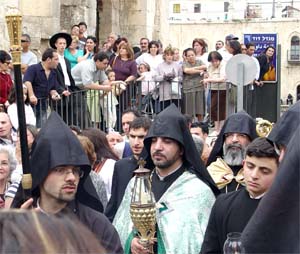 procession.
procession.
Once the procession has finished, we leave the basilica, six hours after entering with the opening of the great door this morning, forming yet another procession, this time to carry the new light of Easter back to the Patriarchate in a long and festive parade of Armenian pilgrims and locals. The role of the luce han is not over until we reach the Patriarchate and the new fire is taken to light the candles in the Cathedral Church of SS. James. Leading us along the way, the scout troop marching bands (pipes, bugles and drums) and that I watched practicing in the courtyard near my rooms the night before.
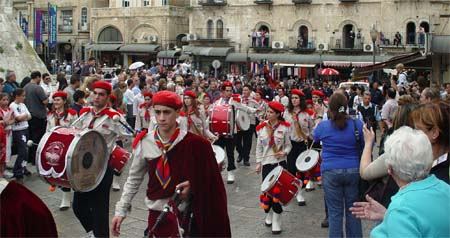
The procession stops when we reach the headquarters of the Jerusalem Police in Old Jerusalem. It seems four Armenian scouts have just been taken into custody following the melee at the beginning of the procession between the Armenian scouts and a group of other youth intent on breaking through the parade. While four of the Armenian scouts are arrested, it seems the Russians ,who may well have caused the disturbance in the first place, were left to go their way.
The Armenian bands stop in front of police headquarters where the scouts have just been taken, to lobby for their release. Archbishop Nourhan and another bishop go inside to negotiate with the authorities and emerge triumphant, to the cheers of the band members, with the freed prisoners walking behind them. Later Patriarch Torkom will compare this problem in trying to proclaim the Resurrection in public with the struggles of the early Apostles who were "also thrown into prison at times."

Following a short liturgy of the light in the Cathedral, we stop to listen to the marching bands perform in the main courtyard of the Armenian compound.
Thus ends the first 7 hours of the celebration of Easter, there will be more than 16 hours in all spent in church in this single 24 hour period (from 9 a.m. Saturday to the same time on Easter Sunday.) So most of us head for our rooms for a short rest before the first Badarak (Divine Liturgy) of Easter is celebrated in the Cathedral, beginning at 4:30 p.m.